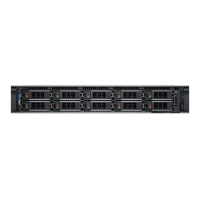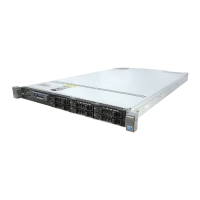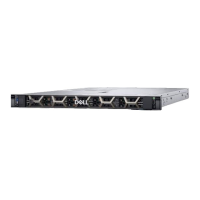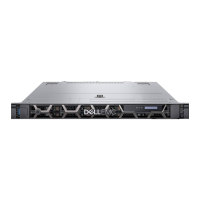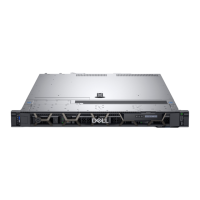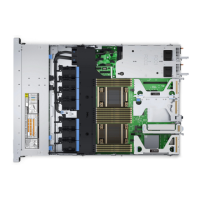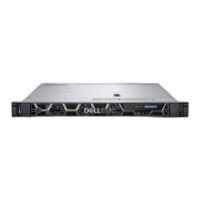Do you have a question about the Dell PowerEdge R630 and is the answer not in the manual?
Details the components and indicators on the server's front panel for system interaction and status.
Describes the connectors and ports located on the back of the server for connectivity and management.
Explains the meaning of front panel diagnostic indicators for system health and error status.
Explains various status indicators for system components like drives, NICs, PSUs, and iDRAC.
Lists available documentation and resources for system setup, configuration, and management.
Details the physical dimensions and weight specifications for different chassis configurations.
Outlines the supported processors, their features, and detailed power supply unit specifications.
Describes memory configurations, supported drive types, and storage options.
Details the specifications for various ports and connectors, including USB, NIC, and serial.
Defines the operating temperature, humidity, and vibration limits for system performance.
Provides a step-by-step guide for unpacking, installing, and connecting the server system.
Explains how to configure iDRAC settings, including IP address, for remote system management.
Outlines methods and resources for installing the operating system on a new server.
Provides instructions on how to download and install the latest BIOS, firmware, and device drivers.
Guides users through configuring system settings, BIOS, and device parameters before OS installation.
Explains how to manage boot options, launch system utilities, and configure PXE boot settings.
Details how to access and configure iDRAC parameters for remote management and system control.
Describes the capabilities of the Dell Lifecycle Controller for system deployment, maintenance, and diagnosis.
Provides essential safety precautions and guidelines before performing any component installation or removal.
Details procedures for removing and installing the system cover to access internal components.
Guides on the correct procedure for removing and installing system memory modules (DIMMs).
Explains how to remove and install various types of hard drives and drive blanks.
Provides detailed steps for removing and installing system processors and their associated heat sinks.
Covers the procedures for installing and replacing AC, DC, and mixed-mode power supply units.
Details the process for removing and installing the system board, including necessary precautions.
Describes the features of iDRAC8, its variants, and methods for acquiring management licenses.
Explains the Intel Xeon processor family and the Intel C610 chipset architecture.
Details memory configurations, population rules, and installation guidelines for RDIMMs and LRDIMMs.
Covers storage expandability, backplane descriptions, and SAS expander daughter card features.
Provides an overview of Dell PERC RAID controller series, including H330, H730, H730P, and H830.
Details the supported PCI Express expansion cards and their installation guidelines.
Explains how to run system diagnostics to test hardware before contacting support.
Describes the function of system board jumpers for configuration and password management.
Provides a visual guide and list of system board connectors and their descriptions.
Offers solutions for issues related to system startup failures and boot mode conflicts.
Addresses problems encountered with iDRAC Direct connections via USB XML or laptop.
Provides steps to diagnose and resolve issues related to system memory modules and slots.
Guides on diagnosing and resolving problems with hard drives, SSDs, and RAID configurations.
Outlines steps to diagnose and resolve issues related to system processors and heat sinks.
Provides information on how to contact Dell for technical assistance, sales, and customer service.
Explains how to use the Quick Resource Locator (QRL) for accessing system-specific information and videos.
Details the components and indicators on the server's front panel for system interaction and status.
Describes the connectors and ports located on the back of the server for connectivity and management.
Explains the meaning of front panel diagnostic indicators for system health and error status.
Explains various status indicators for system components like drives, NICs, PSUs, and iDRAC.
Lists available documentation and resources for system setup, configuration, and management.
Details the physical dimensions and weight specifications for different chassis configurations.
Outlines the supported processors, their features, and detailed power supply unit specifications.
Describes memory configurations, supported drive types, and storage options.
Details the specifications for various ports and connectors, including USB, NIC, and serial.
Defines the operating temperature, humidity, and vibration limits for system performance.
Provides a step-by-step guide for unpacking, installing, and connecting the server system.
Explains how to configure iDRAC settings, including IP address, for remote system management.
Outlines methods and resources for installing the operating system on a new server.
Provides instructions on how to download and install the latest BIOS, firmware, and device drivers.
Guides users through configuring system settings, BIOS, and device parameters before OS installation.
Explains how to manage boot options, launch system utilities, and configure PXE boot settings.
Details how to access and configure iDRAC parameters for remote management and system control.
Describes the capabilities of the Dell Lifecycle Controller for system deployment, maintenance, and diagnosis.
Provides essential safety precautions and guidelines before performing any component installation or removal.
Details procedures for removing and installing the system cover to access internal components.
Guides on the correct procedure for removing and installing system memory modules (DIMMs).
Explains how to remove and install various types of hard drives and drive blanks.
Provides detailed steps for removing and installing system processors and their associated heat sinks.
Covers the procedures for installing and replacing AC, DC, and mixed-mode power supply units.
Details the process for removing and installing the system board, including necessary precautions.
Describes the features of iDRAC8, its variants, and methods for acquiring management licenses.
Explains the Intel Xeon processor family and the Intel C610 chipset architecture.
Details memory configurations, population rules, and installation guidelines for RDIMMs and LRDIMMs.
Covers storage expandability, backplane descriptions, and SAS expander daughter card features.
Provides an overview of Dell PERC RAID controller series, including H330, H730, H730P, and H830.
Details the supported PCI Express expansion cards and their installation guidelines.
Explains how to run system diagnostics to test hardware before contacting support.
Describes the function of system board jumpers for configuration and password management.
Provides a visual guide and list of system board connectors and their descriptions.
Offers solutions for issues related to system startup failures and boot mode conflicts.
Addresses problems encountered with iDRAC Direct connections via USB XML or laptop.
Provides steps to diagnose and resolve issues related to system memory modules and slots.
Guides on diagnosing and resolving problems with hard drives, SSDs, and RAID configurations.
Outlines steps to diagnose and resolve issues related to system processors and heat sinks.
Provides information on how to contact Dell for technical assistance, sales, and customer service.
Explains how to use the Quick Resource Locator (QRL) for accessing system-specific information and videos.
| Display | LCD |
|---|---|
| Built-in display | Yes |
| Dell E-Value Code | PER630_EL0001A_Q1FY18_FG0003_BTP |
| HDD speed | 10000 RPM |
| RAID levels | 0, 1, 5, 6, 10, 50, 60 |
| HDD interface | Serial Attached SCSI (SAS) |
| Optical drive type | DVD±RW |
| Supported HDD sizes | 2.5 \ |
| Total storage capacity | 300 GB |
| Maximum storage capacity | 14 TB |
| Number of HDDs installed | 1 |
| Number of HDDs supported | 8 |
| Supported storage drive interfaces | SAS, Serial ATA III |
| Tcase | 74 °C |
| Bus type | QPI |
| Stepping | R0 |
| Scalability | 2S |
| Processor code | SR2R6 |
| Processor cache | 20 MB |
| Processor model | E5-2620V4 |
| System bus rate | 8 GT/s |
| Processor series | Intel Xeon E5-2600 v4 |
| Processor socket | LGA 2011-v3 |
| Processor threads | 16 |
| Processor codename | Broadwell |
| Motherboard chipset | Intel C610 |
| Processor frequency | 2.1 GHz |
| Processor cache type | Smart Cache |
| Processor lithography | 14 nm |
| Processor manufacturer | Intel |
| Processor package size | 45 x 52.5 mm |
| Processor boost frequency | 3 GHz |
| Processor operating modes | 64-bit |
| Supported instruction sets | AVX 2.0 |
| Thermal Design Power (TDP) | 85 W |
| Compatible processor series | Intel® Xeon® |
| Supported processor sockets | LGA 2011-v3 (Socket R) |
| Maximum number of SMP processors | 2 |
| Maximum number of PCI Express lanes | 40 |
| Memory types supported by processor | DDR4-SDRAM |
| Memory channels supported by processor | Quad |
| Memory clock speeds supported by processor | 1600, 1866, 2133 MHz |
| Memory bandwidth supported by processor (max) | 68.3 GB/s |
| Maximum internal memory supported by processor | 1536 GB |
| Operating system installed | - |
| Compatible operating systems | Microsoft Windows Server 2008 R2 Microsoft Windows Server 2012 Microsoft Windows Server 2012 R2 Novell SUSE Linux Enterprise Server Red Hat Enterprise Linux VMware ESX Microsoft Windows Server 2012 with Hyper-V VMware vSphere ESXi Citrix XenServer |
| Performance management | IPMI 2.0, Dell OpenManage |
| Memory slots | 24x DIMM |
| Internal memory | 16 GB |
| Memory clock speed | 2400 MHz |
| Maximum internal memory | 786 GB |
| Memory layout (slots x size) | 1 x 16 GB |
| Power supply | 750 W |
| Power supply input frequency | 50 - 60 Hz |
| Chassis type | Rack (1U) |
| LAN controller | Broadcom 5720 |
| Cabling technology | 10/100/1000Base-T(X) |
| Ethernet interface type | Gigabit Ethernet |
| USB 2.0 ports quantity | USB 2.0 ports have a data transmission speed of 480 Mbps, and are backwards compatible with USB 1.1 ports. You can connect all kinds of peripheral devices to them. |
| PCI Express slots version | 3.0 |
| Sustainability certificates | ENERGY STAR |
| Operating altitude | 0 - 3048 m |
| Non-operating altitude | 0 - 12000 m |
| Storage temperature (T-T) | -40 - 65 °C |
| Operating temperature (T-T) | 10 - 35 °C |
| Storage relative humidity (H-H) | 5 - 95 % |
| Operating relative humidity (H-H) | 10 - 80 % |
| Processor ARK ID | 92986 |
| Intel Secure Key Technology version | 1.00 |
| Intel Identity Protection Technology version | 0.00 |
| Intel® Identity Protection Technology (Intel® IPT) | No |
| Depth | 701.3 mm |
|---|---|
| Width | 482.4 mm |
| Height | 42.8 mm |
| Weight | 16900 g |
